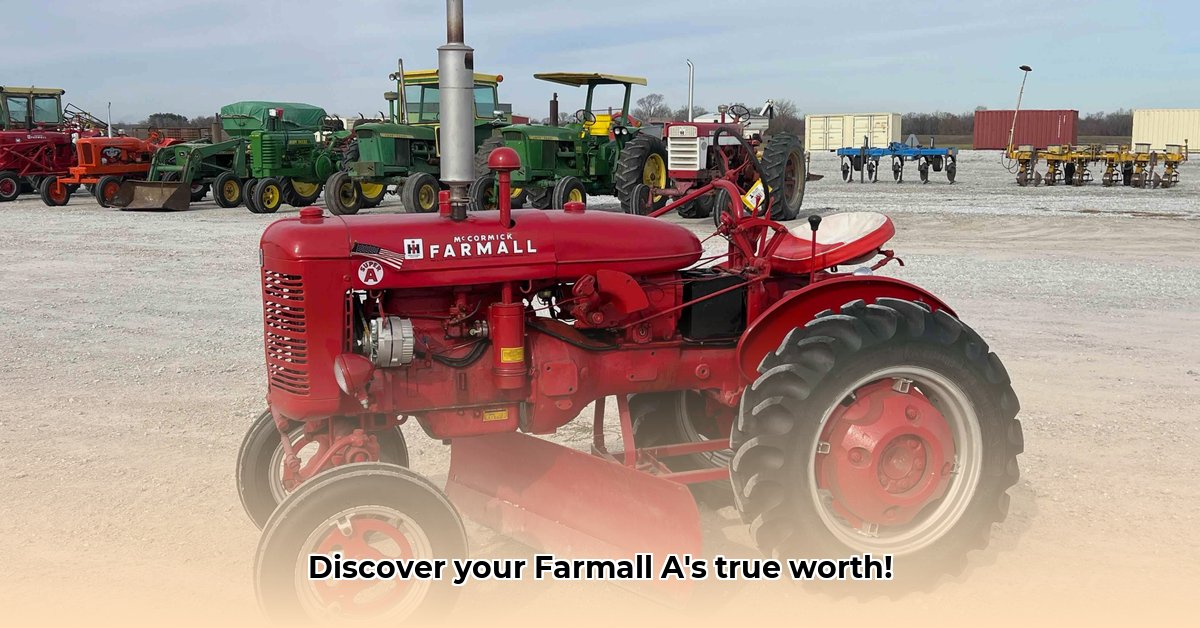
So, you're interested in a 1941 Farmall A tractor? Whether you're buying, selling, or simply curious about its worth, understanding its value requires a methodical approach. This guide provides a comprehensive framework for assessing the price of this classic piece of agricultural history. For additional valuation resources, check out this helpful tractor value guide.
Condition: The Cornerstone of Value
The condition of your 1941 Farmall A is the single most significant factor influencing its value. A meticulously restored tractor will command a significantly higher price than one in poor condition. Think of it like a classic car – a pristine vehicle is worth far more than a rusty wreck. But what defines "good condition"?
Assessing Condition: A Detailed Examination
A thorough inspection is crucial. You need to assess several key areas:
- Engine: Does it run smoothly? A seized or severely damaged engine drastically reduces value.
- Transmission: Do the gears shift properly? Problems here significantly impact worth.
- Body (Sheet Metal): Rust, dents, and missing parts all lower the value. A complete, original body in good shape is highly desirable.
- Tires: Original tires or period-correct replacements add value. Worn or damaged tires detract.
- Accessories: Original tools or attachments significantly boost the tractor's value.
Factors Influencing Value Beyond Condition
While condition is paramount, several other factors play a role in determining a 1941 Farmall A's worth:
- Market Demand: Regional variations in collector interest impact value. Areas with active vintage tractor communities will generally command higher prices. Isn't it interesting how geographical location can affect the value of a piece of equipment?
- Supply and Demand: Current market trends significantly influence pricing. Research recent sales of comparable tractors using online auction sites and forums. The fluctuation of supply and demand is a crucial aspect of economic analysis. This shows that even a classic tractor's price is subject to market forces.
- Completeness and Originality: Original parts and accessories are highly sought after by collectors. A tractor with many original parts will fetch a premium price compared to one with numerous replacements. The higher the originality, the higher its value. A completely original tractor is very rare.
- Restoration Costs: If the tractor requires significant repairs, these costs must be considered when assigning a value—both for buyers and sellers.
Estimating Value: A Step-by-Step Approach
Determining a fair price requires a structured approach. Follow these steps:
- Thorough Inspection: Meticulously inspect the tractor, documenting its condition with detailed notes and photographs. This forms the foundation of your valuation.
- Complete Parts Inventory: List all major components, noting any missing or damaged parts. This helps assess repair costs.
- Research Recent Sales: Examine recent sales of similar tractors online, noting their condition and selling prices. This provides valuable market data.
- Repair/Restoration Cost Estimate: If needed, estimate the costs of repairs or restoration. This is crucial for both buyers and sellers.
- Market Analysis: Research current market trends. Is there high demand for 1941 Farmall A tractors? This context is vital.
- Price Range Determination: Combine your findings to establish a realistic price range. This should reflect the tractor's condition, repair needs, and market value.
Restoring Your 1941 Farmall A: Cost Considerations
Restoring a vintage tractor is a significant undertaking with substantial cost implications. Accurate cost estimation requires careful planning.
Factors Affecting Restoration Costs
The cost of restoration depends on several intertwined factors:
- Tractor's Initial Condition: A heavily damaged tractor will require significantly more work and expense than a well-preserved one. The more significant the damage, the higher the restoration cost, often exponentially so.
- Desired Level of Restoration: A functional restoration focuses on mechanical operation, while a concours restoration aims for pristine factory condition. Concours restoration is significantly more costly.
- DIY vs. Professional Restoration: DIY significantly reduces labor costs but demands time, skills, and tools. Professional restoration is faster but more expensive.
- Parts Availability: Sourcing parts, especially rare ones, can impact restoration costs substantially. The availability and cost of parts are crucial aspects of the budget.
Estimating Restoration Costs: A Practical Guide
- Comprehensive Inspection: Meticulously inspect the tractor, documenting all repair needs.
- Detailed Parts List: Create a complete parts list with cost estimates from multiple suppliers.
- Labor Cost Estimation: Get quotes from professional shops or estimate your time if working DIY.
- Contingency Buffer: Include a contingency fund (10-20%) to address unforeseen issues.
- Total Cost Calculation: Sum all costs to create a realistic budget.
Conclusion: Making Informed Decisions
The value of a 1941 Farmall A tractor is a complex interplay of condition, market factors, and personal sentiment. By following this structured approach, however, both buyers and sellers can make informed decisions based on a clear and comprehensive analysis. Remember, a little research goes a long way in this world of vintage tractors.